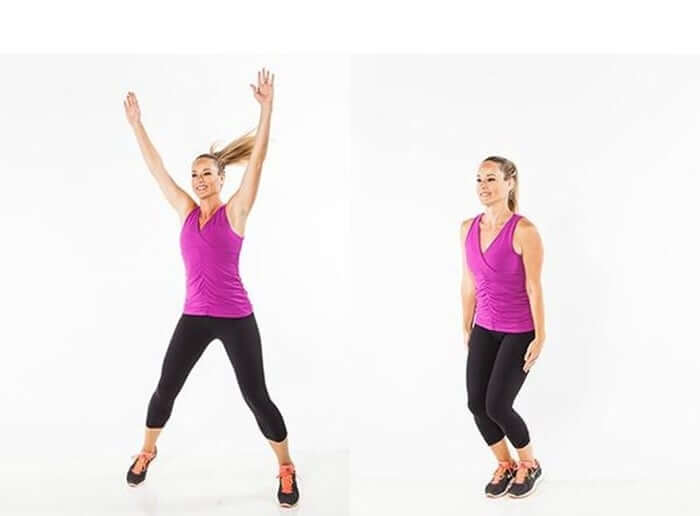Most people, when they start a training routine, have a series of instructions that tell them what to do, how to do it and how often to train. But, one of the easiest and recommended workouts to start is doing cardio exercise, which will give you the physical conditions you need.
The best thing about this exercise is that you can do it practically anywhere: from going for a run in a park or simply doing it from a treadmill at the gym.
If you don't know where to start, we recommend looking at this beginner's cardio guide.

Cardio Beginner's Guide
1. Cardiovascular exercise
Typically the hardest part of exercising is starting over, especially if you don't have the basics of your training, but there are guidelines you can follow to determine the frequency, duration, and activities that work best for you.
A beginner should aim for three to four weekly cardio workouts , for at least 20 to 40 minutes each session. Over time, your goal should be to meet certain established guidelines, which recommend 150 to 300 minutes a week of moderate intensity aerobic exercise, or 75 to 150 minutes a week.
If you are new to cardio, it is recommended to start with something simple, such as walking at a moderate intensity. At the gym, you can use a treadmill, stepper, elliptical, or rowing machine. You can also play recreational sports, do bodyweight movements, or go for a run in the park.

2. Cardiovascular exercise on elliptical machine
If you have access to a gym, the most recommended workout for beginners is with an elliptical . This machine provides a full-body, low-impact cardio workout, plus it's a great way to get beginners comfortable doing aerobic exercise.
This workout is ideal for beginners as it makes the arms and legs move at the same time; Plus, it's gentle on your joints.
We give you an example of how to do a 20-minute elliptical training :
- 3 minutes: Increase the elevation from 1 to 4. Keep your baseline resistance at 5 to 6.
- 2 minutes: Increase the resistance from 6 to 7. You should be working at a little more than a talking pace.
- 3 Minutes: Decrease stamina to a baseline of 5 to 6.
- 2 minutes: Increase endurance from 6 to 7.
- 5 minutes: Decreases stamina at a cooldown rate of 4 to 5.
After you get used to the elliptical, you can move on to the treadmill. Walking on one of them not only helps you improve your cardiovascular condition, but if you do it with incline intervals, you can also work the gluteal area and the hamstrings.

3. Exercise on a treadmill for beginners
The duration of the exercise on the treadmill will vary depending on the incline; For example, if you reach a maximum incline of seven, the workout will be 24 minutes total (including warm-up). On the other hand, if the incline is 15, the training will be 40 minutes (including the warm-up).
For best results, it is recommended to move your arms forward, backward, up and down, as if you were jogging in an open space (it does not matter if this slows you down).
For beginners on the treadmill, this workout is recommended:
- Do a 10-minute warm-up. Start at a low pace and gradually increase the intensity each minute, until you work at a level higher than your "talking pace."
- Walk at a speed between 5 and 6.5 km / h.
- Increase the incline every minute, starting at 0 and ending at 15. This is the maximum incline you should follow, but it is also okay to stop at an incline that is comfortable for you, which can be between 7 and 10.
- Once you reach your maximum incline, go back down every minute until you reach zero.
- Cool down your body with an easy 5-8 minute walk, followed by stretching.

4. Cardiovascular exercises at home
4.1 Jumping jacks
- Stand up straight with your hands at your sides.
- Jump by opening your feet to the sides and raise your hands above your head.
- Bring your feet back together and lower your hands to your sides.

4.2 Squats
- Stand with your feet hip-width apart.
- Bend your knees and roll your hips back, as if you were sitting in a chair, keeping your weight on your heels.
- Lower yourself until your thighs are parallel to the floor (or as far away as your mobility allows).
- Step back, squeezing your glutes (glutes) at the top.

4.3 Burpees
- Stand up straight with your feet shoulder-width apart.
- Place your hands on the ground between your feet.
- Step your feet back, one at a time, until you are in a high Planck position (top of a push-up), balancing your hands and feet, your body in a straight line from head to heels.
- Move your feet towards your hands.
- Stand up and spread your hands over your head.

4.4 Push-ups
- Begin in a high plank position, balancing your hands, feet, and body in a straight line from head to heels. If you want it to be easier, start on your knees.
- Bend your elbows at a 45-degree angle to your body and lower your chest to the floor.
- Push through your hands to return to a plank position.

How to do cardiovascular exercise effectively
- Select your exercises well: When you start cardiovascular exercise, you need to make sure you choose an exercise that you should be able to do; also you should not do it at an intensity that can cause injury. Doing it at a high intensity can cause you to overtrain or it can decrease results.
- You need to make sure you stay well hydrated. For people who exercise, an amount of up to 3 liters per day is recommended.
- To be safe and maximize each workout, you should plan your exercises during the week. Beginners should not run a cardio workout on 2 consecutive days.
- Use a heart rate monitor: Coaches recommend using a heart rate monitor in order to measure the intensity of your heart rate ranges. This is a smart way to keep your body safe and improve your performance.

References
- Sara, L. Your Straightforward Guide to Getting Started With Cardio. For Livestrong [Revised December 2019].
